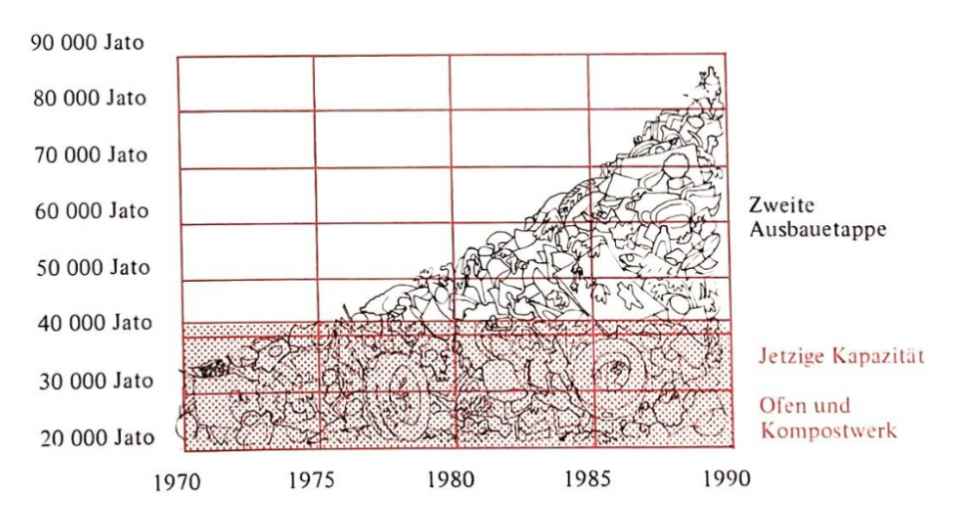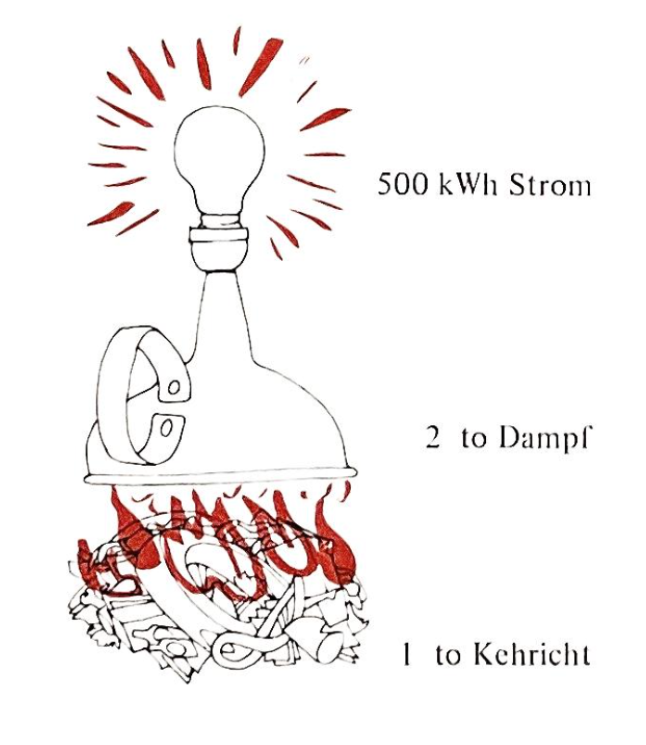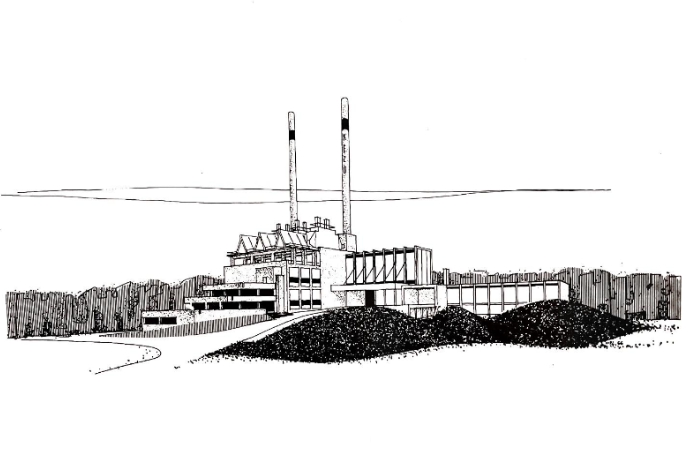During the prospering postwar era, waste accumulations in the Zurich region emerged as a disruption within the landscape. Discharged from towns and villages and relegated to forest landfills, waste encroached increasingly upon the Zurich landscape, manifesting itself even when out of plain sight through olfactory discomforts, thus rendering the dumps controversial among local inhabitants. In response to the escalating issue of uncontrolled landfills, the inception of the waste plant KEZO (Kehrichtverwertung Zürcher Oberland (Waste Recycling in the Zurich Oberland)) was established in 1961 after a referendum in the southeastern area of the Canton of Zurich known as Zürcher Oberland.

Photograph of the key displayed at the waste incineration plant’s entrance for the second expansion’s ceremonial opening in 1977.
Photograph of the key displayed at the waste incineration plant’s entrance for the second expansion’s ceremonial opening in 1977.
© gta Archive / ETH Zürich, Pierre Zoelly. Used by permission.
The copyright holder reserves, or holds for their own use, all the rights provided by copyright law, such as distribution, performance, and creation of derivative works.
Articles in the major newspaper Neue Zürcher Zeitung discussing KEZO’s founding employed figurative compound words such as “garbage flood” and “garbage avalanche,” conjuring up images of a manmade disaster. KEZO’s own brochure, Wie geht es weiter? (What’s Next?), attributed the founding to the “disfiguration of the landscape by smoking and stinking waste pits.” These landfills, which create a landscape experience characterized by unsettling aesthetic impressions, along with scientifically diagnosed hygienic risks posed by air, soil, and water pollution, motivated policymakers to implement solutions.

The diagram illustrates the forecast that bears a striking resemblance to a “garbage avalanche.”
The diagram illustrates the forecast that bears a striking resemblance to a “garbage avalanche.”
© gta Archive / ETH Zürich, Ullin Streiff, Planning Zurich Oberland. Used by permission.
The copyright holder reserves, or holds for their own use, all the rights provided by copyright law, such as distribution, performance, and creation of derivative works.
As an initial step in KEZO’s multistage development, a composting plant emerged in 1963 between the municipalities of Hinwil and Wetzikon. The compost could, as in earlier times, be used as fertilizer in agriculture, reintroducing valuable nutrients into the soil. However, by 1965, the volume of compost generated surpassed regional agricultural demands, resulting in approximately 30 percent utilization within the region, while the surplus had to be exported to neighboring regions.
In addition, industrial waste posed a challenge to composting due to its composition. The open facilities faced difficulties processing “poisons, explosive liquids, and other chemicals.” Previously, composting not only efficiently disposed of waste but also reintegrated it into natural cycles. However, the acceleration of waste production from a burgeoning consumer society, compounded by technical materials from industry, thwarted the feasibility of disposing of waste naturally within reasonable time.

Diagram aiming to demonstrate how useless waste is converted into useful energy.
Diagram aiming to demonstrate how useless waste is converted into useful energy.
© gta Archive / ETH Zürich, Ullin Streiff, Planning Zurich Oberland. Used by permission.
The copyright holder reserves, or holds for their own use, all the rights provided by copyright law, such as distribution, performance, and creation of derivative works.
As indicated by the Aktion Saubere Schweiz (Clean Switzerland Campaign), the notable surge in household waste primarily stems from the increased use of packaging materials and their subsequent disposal in domestic waste. The shift away from reusing glass bottles and burning paper and cardboard at home, following the disappearance of domestic stoves due to the introduction of oil heating, contributed to rising combustible materials in household waste.
KEZO’s expansion into a waste incineration plant during subsequent stages presented itself as the solution to industrial mass production’s adverse effects. Incineration aimed to artificially expand the limits of the landscape by reducing waste volume through incineration, allowing the landscape to absorb more without reaching socially unacceptable levels. While cleansing meadows and forests of waste, an orderly experience of the Zurich landscape was restored.
Moreover, the incineration plant provided additional electricity to consumers. A diagram published by KEZO lauded its achievements, depicting the fire’s red hue and rays of light to demonstrate to a naïve audience how “pyrotechnics” harnessed useless waste to generate useful energy—waste which could have been at least partly repurposed meaningfully.
In a design rendering by its renowned architect Pierre Zoelly, the KEZO rises monumentally amidst a composite landscape, featuring both artificial and natural elements as it were, of the compost or slag residues from the incineration. This composite landscape is placed in the foreground as a chain of hills, with a row of trees running along the horizon in the background. Zoelly appeared to portray the waste piles as landscape elements with a strategic role in waste reintegration. The viewer, contemplating the interplay of foreground, middleground, and background, could discern KEZO’s role in maintaining the landscape. A single cloud adorns the sky, above smokeless slender chimneys. The drawing thereby suggests that waste incineration, facilitated by filter technology, embodies a clean process, as if the waste would be harmlessly dissipating.
Within the facility, the incineration process underwent surveillance through monitors. These mechanical eyes enabled the control of waste materials that were not intended to be part of the landscape. While the utilization of fire for maintenance of the landscape represented the production of an ecology, it concurrently constructed the topos of a landscape. If the landscape’s definition depended on the absence of waste, the landscape was surveilled from inside. The control room, equipped with screens and measuring instruments, formed the hidden “back side” of the landscape.
Symbolically, a key displayed at the waste incineration plant’s entrance for the second expansion’s ceremonial opening in 1977 underscored KEZO’s self-perception as a “landscape producer.” Representing water, soil, sky, flora, and fauna through a topographical section, the key symbolized a pristine and healthy landscape, promising a “green” future. But waste returned in energy and material units imperceptible to the senses: as electricity for appliances, industrial teleheating, slag for roads, or dispersed gas in the atmosphere.
The KEZO projected itself as the producer of a blooming landscape, a standpoint requiring critical re-evaluation within contemporary context. The smokeless chimneys of Zoelly’s drawing suggested waste was “disappearing into thin air” effortlessly; however, the implications of heightened carbon emissions had yet to be considered as an assessment parameter. KEZO emerged from a spirit that still perceived planet Earth as an endless resource and its atmosphere as an infinite repository.
Acknowledgment
This essay derives from the project conducted by the Chair of the Theory of Architecture, Prof. Dr. Laurent Stalder, ETH Zürich, with supervision provided by Dr. Andreas Kalpakci.
How to cite
Schweizer, Jan. “Limits of the Landscape: A Waste Incinerator for Zurich’s Countryside.” Environment & Society Portal, Arcadia (Spring 2024), no. 5. Rachel Carson Center for Environment and Society. https://www.environmentandsociety.org/node/9830.
ISSN 2199-3408
Environment & Society Portal, Arcadia
 This work is licensed under a Creative Commons Attribution 4.0 International License.
This work is licensed under a Creative Commons Attribution 4.0 International License.
2024 Jan Schweizer
This refers only to the text and does not include any image rights.
Please click on an image to view its individual rights status.
- Daston, Lorraine, and Peter Galison. “The Image of Objectivity.” Representations 40 (1992): 81–128. https://doi.org/10.2307/2928741.
- Douglas, Mary. Purity and Danger. New York: Routledge, 1984.
- Jany, Susanne. “Making Buildings Work.” In Architecture/Machine: Programs, Processes, and Performances, edited by Laurent Stalder and Moritz Gleich, 70–81. Zürich: gta Verlag, 2017.
- Kühn, Friedrich. “Energieerzeugung in der Kehrichtsverbrennungsanlage Zürcher Oberland (KEZO) [Energy Generation in the Zürcher Oberland Waste Incineration Plant (KEZO)].” Wasser Energie Luft 71, no. 4 (1979): 70–73. doi.org/10.5169/seals-941440.
- Ponte, Alessandra. “Müllschlucker: Die Domestizierung des Abfalls, [Rubbish chutes: The domestication of waste].” Arch+: Der Schwellenatlas 191/192 (2021): 78–83.
- Reimann, Sandra Beate. Territories of Waste: Über die Wiederkehr des Verdrängten / On the Return of the Repressed. Basel: Museum Tinguely, 2022.
- Zoelly, Pierre. Werkbuch [Workbook]. Basel: Birkhäuser, 1998.










